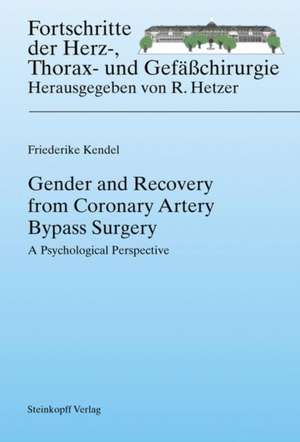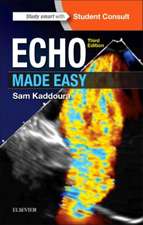Gender and Recovery from Coronary Artery Bypass Surgery: A Psychological Perspective: Fortschritte in der Herz-, Thorax- und Gefäßchirurgie, cartea 7
Autor Friederike Kendelen Limba Engleză Paperback – 20 noi 2008
Preț: 361.06 lei
Preț vechi: 380.07 lei
-5% Nou
Puncte Express: 542
Preț estimativ în valută:
69.11€ • 75.09$ • 58.09£
69.11€ • 75.09$ • 58.09£
Carte tipărită la comandă
Livrare economică 21 aprilie-05 mai
Preluare comenzi: 021 569.72.76
Specificații
ISBN-13: 9783798518551
ISBN-10: 3798518556
Pagini: 108
Ilustrații: VIII, 104 p. 11 illus., 8 illus. in color.
Dimensiuni: 170 x 242 x 6 mm
Greutate: 0.23 kg
Ediția:2009
Editura: Steinkopff
Colecția Steinkopff
Seria Fortschritte in der Herz-, Thorax- und Gefäßchirurgie
Locul publicării:Heidelberg, Germany
ISBN-10: 3798518556
Pagini: 108
Ilustrații: VIII, 104 p. 11 illus., 8 illus. in color.
Dimensiuni: 170 x 242 x 6 mm
Greutate: 0.23 kg
Ediția:2009
Editura: Steinkopff
Colecția Steinkopff
Seria Fortschritte in der Herz-, Thorax- und Gefäßchirurgie
Locul publicării:Heidelberg, Germany
Public țintă
Professional/practitionerCuprins
Introduction: Gender Differences in Mortality After CABG.- Gender Aspects of Risk Factors.- Outcome Measures.- Hypotheses: Gender Differences in Risk Factors and Outcomes.- Moderator Hypotheses.- Mediator Hypotheses. Method: Participants.- Measurements.- General Statistical Procedures.- Sample.- Results: Predictors of Mortality and Physical Functioning Based on Preoperative Data.- Predictors of Well-Being Based on Longitudinal Data.- Predictive Relationship Between Physical Functioning and Depression.- Discussion: Gender Differences in Outcome.- Gender Aspects in Recovery.- Is Depression Predictive for Physical Functioning?- Limitations.- Clinical Implications.- Conclusion.- Summary.- References
Textul de pe ultima copertă
The number of coronary artery bypass graft (CABG) operations has increased continually over the past decade. To date, roughly one-third of these are performed on women. Despite the tremendous progress made in cardiovascular surgery, not all patients profit equally from it, and the mortality rate of women still exceeds that of men by a factor of two. Studies conducted to investigate this marked gender difference have yielded conflicting results. In particular, adjustment for clinical risk factors seemed to diminish the difference, but could not fully explain it.
Therefore psychosocial parameters, in particular depression and psychosocial stress, have gained increasing attention as predictors for both mortality and quality of life after CABG operation. Gender differences in these variables have long been observed in patients undergoing CABG: female patients are on average older, more often depressive and more often living alone than male patients. This book presents the very first German study to focus on these gender differences.
By describing the gender-specific influence of psychological and clinical variables on the recovery process, this work fills an important gap in cardiovascular research. Its approach is interdisciplinary in the best sense. The study underlines the importance of psychosocial variables for both mortality and quality of life in the context of CABG. Thus, it may be seen as a basis for a better understanding and treatment of CABG patients.
Therefore psychosocial parameters, in particular depression and psychosocial stress, have gained increasing attention as predictors for both mortality and quality of life after CABG operation. Gender differences in these variables have long been observed in patients undergoing CABG: female patients are on average older, more often depressive and more often living alone than male patients. This book presents the very first German study to focus on these gender differences.
By describing the gender-specific influence of psychological and clinical variables on the recovery process, this work fills an important gap in cardiovascular research. Its approach is interdisciplinary in the best sense. The study underlines the importance of psychosocial variables for both mortality and quality of life in the context of CABG. Thus, it may be seen as a basis for a better understanding and treatment of CABG patients.
Caracteristici
Includes supplementary material: sn.pub/extras


















